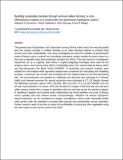| dc.contributor.author | Gumisiriza, Margaret | |
| dc.contributor.author | Ndakidemi, Patrick | |
| dc.contributor.author | Nalunga, Asha | |
| dc.contributor.author | Mbega, Ernest | |
| dc.date.accessioned | 2023-04-25T09:03:12Z | |
| dc.date.available | 2023-04-25T09:03:12Z | |
| dc.date.issued | 2022-08 | |
| dc.identifier.uri | https://doi.org/10.1016/j.scs.2022.103923 | |
| dc.identifier.uri | https://dspace.nm-aist.ac.tz/handle/20.500.12479/1883 | |
| dc.description | This research article was published by Elsevier in 2022 | en_US |
| dc.description.abstract | The growing rate of population and urbanization among African cities versus the reducing arable land has roused curiosity in soilless farming as an urban farming method to enhance food security and urban sustainability. This study investigated the economic viability of producing 60 heads of lettuce using a vertical non-circulating hydroponic system outside the green house as a low cost sustainable urban food production prospect for Africa. This was based on a hydroponic experiment set up in Uganda, East Africa 4 capital budgeting techniques were used for the analysis, that is; Net Present Value (NPV), Profitability index (PI), Internal Rate of Return (IRR) and Non-discounted Pay Back Period (NDPBP). A sensitivity and scenario analysis were adopted for risk analysis while regression analysis was considered for forecasting and modelling purposes. A discount rate of 10% was considered for the analysis based on the loan borrowing rate. The unit production cost equaled to 0.46$/head and sale price was estimated at 0.75/head. Initial costs deemed necessary for annual production were estimated at 171.1$. Results showed the following economic values: NPV (16.37$), IRR (12.57%), PI (1.1) and NDPBP (4,5) for annual crop production of 6 cycles. NPV was sensitive to changes in discount rate and unit price while revenue varied with a change in quantities sold and unit price as per the scenario analysis. A significant negative and positive linear relationship was found between unit price of lettuce versus quantity sold and revenue earned correspondingly. Adoption of vertical hydroponic lettuce production can be considered an equally cost-effective venture with substantial profits cetris paribus with the potential to increase food security and sustainability around urbanities. Further research needs to be done to assess the profitability of producing other vegetables using the same system across various seasons and cities. | en_US |
| dc.language.iso | en | en_US |
| dc.publisher | Elsevier | en_US |
| dc.subject | Research Subject Categories::NATURAL SCIENCES | en_US |
| dc.title | Building sustainable societies through vertical soilless farming: A cost-effectiveness analysis on a small-scale non-greenhouse hydroponic system | en_US |
| dc.type | Article | en_US |

